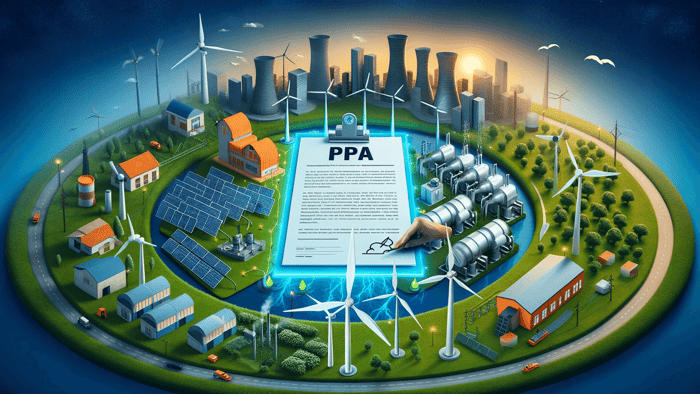Mini-perm ("MP") loans play a strategic role in project finance, particularly for large-scale infrastructure and energy projects. These loans offer a shorter-term financing solution that bridges the initial phase of construction to the project's operational phase. The key advantage of opting for a mini-perm loan lies in its flexibility; it allows developers to refinance at potentially lower interest rates and more favorable debt-sizing terms once the project demonstrates stable cashflows based on past performance. This approach is not just about avoiding the commitments of long-term financing from the start; it represents a calculated decision by developers to take on refinancing risk. They anticipate that future market conditions will be more favorable, despite the possibility that rates could rise. In making this proactive choice, developers are pro-actively seeking more acceptable financing conditions in the future –positioning their projects for a more advantageous financing solution in the future.
Key Takeaways: Navigating the Strategic Advantages of Mini-Perm Loans
· Strategic Importance: Mini-perm loans are essential financing solutions for financing large-scale infrastructure and renewable energy projects.
· Bridging Finance: They provide a shorter-term solution to bridge the gap from construction to operational phase.
· Flexibility for Refinancing: Offers the ability to refinance under potentially more favorable conditions once the project is in operation.
· Risk and Reward: Developers take calculated refinancing risks, betting on improved market conditions in the future.
· Proactive Financial Planning: This choice reflects a strategic move to secure better financing terms later, aligning with long-term project success.
Navigating Repayment Structures in Renewable Energy Finance
In the landscape of renewable energy project financing, understanding the nuances of different repayment structures—such as bullet, balloon, mini-perm, and long-term financing—is crucial. Each has its specific applications and implications for project sponsors and financiers alike.
· Bullet Repayment: Rare in project finance, this structure involves interest-only payments during the loan term, with the principal due in a lump sum at maturity. Given the stable cash flows typical of renewable energy projects, accumulating sufficient funds for a large, one-time payment poses significant challenges, often necessitating refinancing.
· Balloon Repayment: A variation that introduces principal repayments before maturity, balloon payments reduce the lender's exposure compared to bullet loans. However, the principal is not fully amortized, leading to a substantial final payment. This structure, while slightly more favorable than bullet repayments, still frequently requires refinancing to manage the remaining balance.
· Mini-Perm Financing: Specifically tailored for the initial years of a project's life, mini-perm loans typically include a balloon payment at the end of their term, necessitating refinancing to settle the outstanding principal. During the mini-perm period, principal repayment starts according to a pre-defined schedule, aiming to reduce the debt before the balloon payment comes due. Banks offering mini-perm loans are aware of the refinancing risk—that at maturity, the project may not secure sufficient funds for full refinancing. They often mitigate this risk with contractual provisions like a full cash sweep mechanism post-maturity if refinancing isn’t achieved. This means that should refinancing not be available, all project cash flows after operational expenses and taxes (CFADS) are directed to the bank, leaving equity investors without cash flows until the debt is fully repaid.
· Long-Term Financing: Spanning typically between 15 to 25 years, long-term loans are designed to more closely match the operational lifespan of renewable energy projects, allowing for gradual debt amortization. This approach aligns debt service with the project's stable cash flow generation over time, providing a more predictable financial planning framework.
Each financing structure brings its own set of strategic considerations for renewable energy projects, with mini-perm loans standing out for their flexibility in the face of uncertain future market conditions. Developers must weigh the immediate benefits of securing long-term financing at potentially higher interest rates and the strategic advantage of potential future refinancing against the risks of market volatility and refinancing availability.
The Role of Interest Rates and Market Conditions in Financing Decision-Making
The interplay between interest rates, market conditions, and hedging requirements plays a crucial role in the strategic financing decisions of renewable energy projects. Specifically, in the realm of mini-perm financing, understanding these elements is essential for navigating the financial landscape effectively.
Interest Rates and Financing Choices
The choice between mini-perm and long-term financing is significantly influenced by the current interest rate environment. With their shorter durations and inherent refinancing needs, MP loans present a unique risk profile in fluctuating rate conditions. When interest rates are expected to decrease or remain stable, developers might lean towards mini-perm financing, anticipating cheaper refinancing options in the future. Conversely, in a low-interest-rate environment where rates are expected to rise, securing long-term financing could be more appealing to lock in the favorable rates for the project's lifespan.
Market Conditions and Economic Trends
Beyond the immediate interest rate environment, broader economic and market trends can influence financing decisions. A booming economy might signal rising interest rates, and once these higher interest rates materialize, pushing developers towards mini-perm loans with the hope of refinancing at more reasonable rates in the future. Alternatively, in a stable or declining economic environment, the certainty of long-term financing might be more attractive.
Hedging Requirements in Mini-Perm Financing
Hedging plays a critical role in managing the interest rate risk associated with MP loans. Banks most typically require hedging of 75% and up to 125% of the debt notional of the scheduled repayment structure, including the balloon repayment expected at the refinancing event. This hedging safeguards against the risk of floating interest rate increases during the mini-perm tenor, ensuring that the interest payments on the hedged portion of the debt remain stable, while the unhedged portion could vary with market rates.
The notional amount refers to the principal amount of debt that the hedge aims to protect against interest rate fluctuations. Hedging policies can vary, with some banks demanding hedges that extend beyond the mini-perm's maturity, anticipating the risk that refinancing may not occur. These extended hedges are based either on the expected cash sweep mechanism, determined by the financial model at financial close of the mini-perm financing, or on the even longer theoretical sizing profile that originally determined the mini-perm's balloon payment.
When refinancing does take place, the existing hedge must be terminated, leading to a mark-to-market (MtM) event. This event can result in either a cost or a gain for the project, depending on the prevailing interest rates relative to the rates locked in by the hedge. If interest rates have risen, breaking the hedge might result in a gain, as the project had been protected against higher rates during the hedge period. Conversely, if rates have fallen, the project faces a potential cost, as it had been paying for protection against a rise in rates that did not materialize. This MtM event adds another layer of financial complexity and risk management to consider during the refinancing process, emphasizing the importance of strategic financial planning in the development and ongoing management of renewable energy projects.
In a nutshell, hedging acts as a double-edged sword; it guards against the potential financial strain of rising interest rates during the mini-perm period, ensuring that the project is shielded from fluctuations that could impact its cost structure unfavorably. However, this protection comes with its own set of complexities, particularly when it comes time to refinance. The termination of the hedge at refinancing introduces a mark-to-market (MtM) event that could either benefit or disadvantage the project, depending on the interest rate movements since the hedge was put in place. If rates have increased, the project may realize a gain, having been protected against higher costs during the hedged period. Conversely, if rates have decreased, the project could face additional costs for hedging against a rise that didn’t occur. This dynamic underscores the critical role of hedging as a nuanced risk management tool in renewable energy project financing, essential for navigating the financial intricacies and ensuring stability and predictability in the face of market volatility.
Mini-Perm Sizing Approach: Debt Sculpting with Target DSCRs
When structuring the financing for renewable energy projects, the approach to determining the size of a mini-perm loan involves a meticulous process known as debt sculpting. This method tailors the loan repayment profile to the project's expected cash flow, ensuring that debt service is both manageable and aligned with the project's ability to generate cash flows over time.
Debt sculpting starts with determining the project's cash flow available for debt service (CFADS). CFADS represents the net cash flow generated by the project after operational expenses and taxes, which is available to pay back the debt. The repayment profile is then sculpted by dividing the CFADS by a target Debt Service Coverage Ratio (DSCR). The DSCR is a critical measure in project finance that indicates the project's ability to cover its debt obligations – anything above a DSCR of 1.00x is essentially a buffer against potential cash flow variability.
For renewable energy projects, which often face fluctuations in revenue due to variable production outputs and market prices, the distinction between contracted and uncontracted revenues is crucial in the sculpting process. Moreover, this variability leads lenders to use more conservative projections, such as P90 energy production levels, as their basis for financial modeling. A P90 level means there's a 90% confidence that energy production will exceed the specified amount, making it a conservative estimate compared to the more optimistic P50 scenario, which stands at a 50% probability.
Contracted revenues, secured through Feed-in Tariffs, Power Purchase Agreements (PPAs), or other fixed income streams, are seen as more predictable. Thus, they can be matched with a lower target DSCR, such as 1.15x. This ratio suggests that for every dollar of debt service, the project is expected to generate $1.15 in CFADS.
Uncontracted revenues, which depend on market rates and production levels, carry higher uncertainty and risk. Accordingly, they warrant a higher target DSCR, perhaps 1.25x, to ensure a larger financial cushion. This higher DSCR for uncontracted revenues accounts for the added risk of relying on market conditions, making it a prudent choice when modeling cash flows based on P90 energy production levels.
By employing targeted DSCRs based on conservative energy production levels like P90, financial planners can design a loan structure that accommodates the specific cash flow characteristics and risk exposure of renewable energy projects. This strategic approach to mini-perm loan sizing ensures that the financing solution supports the project's long-term cash flow generation, providing a robust framework for managing the inherent variability in renewable energy production.
Strategic Considerations for Mini-Perm Financing
· Interest Rate Predictions: Assess current and forecasted interest rates to determine the potential benefits of refinancing post-mini-perm phase.
· Market Conditions Analysis: Stay informed about economic and market trends that could influence refinancing options and interest rates at the time of mini-perm loan maturity.
· Hedging Strategy: Implement hedging strategies to manage interest rate risk, considering the proportion of the debt to hedge based on project-specific risks and bank requirements. Understand the implications of hedging policies, including the potential need to hedge beyond the mini-perm maturity, and prepare for the mark-to-market (MtM) event upon refinancing.
· Cash Flow Projections: Utilize conservative energy production levels (e.g., P90) for financial modeling to ensure that debt service coverage ratios (DSCRs) are realistic and provide a sufficient financial buffer.
· Contracted vs. Uncontracted Revenues: Evaluate the proportion of contracted versus uncontracted revenues to determine appropriate DSCR targets, reflecting the project’s revenue stability and risk profile.
· DSCR Targets: Set targeted DSCRs based on the mix of contracted and uncontracted revenues and the project’s overall risk assessment, ensuring that loan repayments are manageable within the projected cash flows.
· Refinancing Risks: Be proactive in planning for refinancing, considering the potential challenges and market conditions that could impact the availability of favorable refinancing options.
· Operational Phase Transition: Plan for a smooth transition from construction to operational phase, ensuring that the project meets performance expectations to facilitate favorable refinancing terms.
· Lender Negotiations: Engage in transparent and strategic discussions with lenders to explore flexible financing structures that accommodate the project’s unique aspects and potential future changes in market conditions.
· Long-term Financial Stability: Balance the immediate benefits of a mini-perm loan with the long-term financial stability of the project, considering how refinancing risks and interest rate fluctuations could impact project viability over time.
Incorporating these strategic considerations into the financing decision-making process will enable project developers to navigate the complexities of mini-perm financing more effectively, aligning financial structures with project goals and market realities.
Navigating Future Landscapes: The Strategic Role of Mini-Perm Financing in Renewable Energy Projects
In the rapidly evolving world of renewable energy, the strategic deployment of MP loans offers a nuanced financial pathway for large-scale infrastructure and energy projects. This financing strategy bridges the critical gap from construction to operational viability, setting the stage for sustainable project development. By integrating mini-perm loans into their financial planning, developers not only tackle the immediate challenges of project finance but also strategically position themselves to benefit from future market conditions. This foresight allows for potentially lower interest rates and more favorable debt-sizing terms, reflecting a proactive approach to financial management and risk mitigation.
As we reflect on the journey of renewable energy financing, a few key insights emerge:
· The Flexibility of Mini-Perm Loans: At the heart of mini-perm financing lies the flexibility it offers. Unlike traditional long-term loans, mini-perms cater to the project's early stages, providing an opportunity for refinancing under potentially improved terms once operational stability is demonstrated.
· Anticipation of Market Conditions: The decision to opt for mini-perm financing is inherently forward-looking. Developers take calculated risks, anticipating shifts in market conditions that could favor future refinancing opportunities. This strategy underscores the importance of adaptability in financial planning, acknowledging the dynamic nature of interest rates and economic trends.
· Strategic Risk Management: Employing mini-perm loans is a testament to strategic risk management. Developers consciously choose to navigate the refinancing risk, balancing the immediate benefits of flexible, shorter-term financing against the backdrop of potential long-term gains.
· Comprehensive Financial Planning: The utilization of mini-perm loans highlights the need for comprehensive financial planning. From hedging interest rate risks to sculpting debt repayments based on conservative energy production estimates, this approach demands a meticulous evaluation of various financial factors.
In essence, mini-perm financing exemplifies a strategic financial solution tailored to the unique demands of renewable energy projects. It not only addresses the immediate financial needs during the critical phase of project development but also aligns with a vision for future financial stability and success. As the renewable energy sector continues to grow and diversify, the strategic application of mini-perm loans will play an essential role in shaping the financial landscapes of these vital projects, ensuring they thrive in an ever-changing economic environment.






